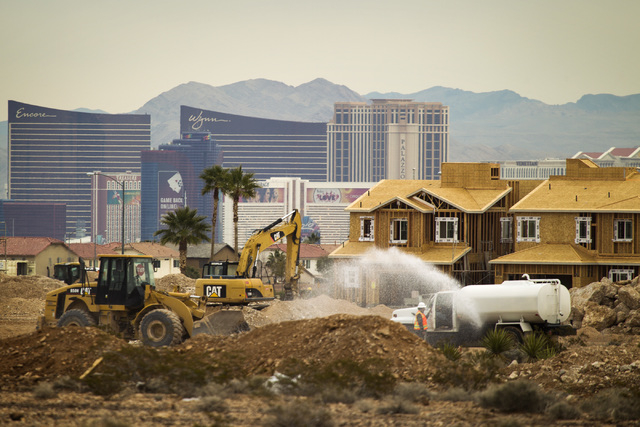Nevadans still want houses despite state of economy, job growth
A few headwinds won’t be enough to completely blow back housing gains in coming years.
That’s the word from a national housing expert in town Friday for a real estate convention at the Palms.
Neither sluggish employment gains nor slower-than-normal economic growth are likely to restrain consumer demand for homes in 2015 and 2016, said Lawrence Yun, chief economist and senior vice president of research for the National Association of Realtors. Yun spoke to about 200 real estate agents from the West in Las Vegas for this week’s Rocky Mountain Region 11 Conference, organized and sponsored by the Nevada Association of Realtors.
Here’s why housing should get a boost in coming quarters, according to Yun.
First, the nation’s gross domestic product has posted big recent gains, surging 4 percent to 5 percent in the second and third quarters. The U.S. economy is adding jobs, too: It lost 8 million positions in the recession, but has added 11 million jobs since. The unemployment rate is 5.7 percent, and household net worth is at an all-time high because of a soaring stock market. Steep declines in first-time filings for jobless benefits are a “leading indicator” that job growth will continue, Yun said.
For Mountain West states including Nevada, Arizona and Utah, the outlook is even stronger, because regional job formation is besting national rates, Yun said. Population growth in the West is above-average, too.
“Nevada is consistently getting new residents because of its low taxes and its business environment,” Yun said.
And where there are population gains and job growth, there’s demand for housing, Yun said.
Now, about those headwinds.
GDP may have surged in mid-2014, but the indicator has yet to put together a full year of strong increases, Yun said. In fact, it’s been nine years since GDP averaged at least 3 percent growth over a four-quarter period, Yun said. Compare recent GDP trends to historic norms, and U.S. economic growth is underperforming long-term averages by $1.5 trillion, or $4,700 per person.
And even as unemployment is down, so is employment, or the number of Americans working. About 63 percent of the nation’s adults had jobs before the recession; today, that rate is at 58 percent — a “consequence of subpar economic expansion,” Yun said.
There’s also evidence that, for now at least, America has become a “renter nation,” Yun said. Since the downturn, the country’s renter population has increased by 9 million households, while homeowners have dwindled by 1 million households. That, in turn, creates unequal distribution of wealth, because renters have an average net worth of $5,500, well below the $195,000 average among homeowning households.
Still, demand for housing is set to rise, and that could mean a supply crunch.
That’s because housing starts in Nevada and across the nation are barely in growth territory, well below their norms, Yun said. Builders nationwide are struggling to develop amid a labor shortage, rising construction costs and a credit crunch, especially among small builders looking for local lending.
That lack of inventory could soon run headlong into growing demand, Yun said.
Consider that the nation saw 5.2 million existing-home sales and 880,000 new-home sales in 2000, when the country had 132 million payroll jobs and a population of 282 million. In 2014, with payroll jobs up to 138.9 million and population at 319 million, the U.S. market closed on just 4.9 million resales and 440,000 new homes, Yun said.
The 37 million new Americans ready to “pop out” into the market include renters, some of whom are living with three and four roommates, he said. It also includes millennials living in extended families.
“So you made it through the worst. You’re seeing better conditions, but you’ll likely see even better conditions because of sizable pent-up demand,” Yun said. “Living in your parents’ basement is no one’s idea of the American dream. As the job market improves, people will hopefully move out of their parents’ basement.”
Also, the shadow inventory — homes that have yet to come on the market as distress sales — is “rapidly declining,” Yun said.
In Nevada, the housing market’s “degree of collapse was high, but you’re seeing a steady comeback,” Yun said.
The market is “even,” but there’s a looming inventory shortage thanks to several years’ worth of little to no new construction, Yun said. Nevada is seeing just 30 percent of its normal construction inventory as measured by housing permits.
“Without more new-home construction, your inventory shortage could last a while,” he said.
Also, as new rules take effect that will lower insurance premiums on federally backed loans, more people will be able to afford to buy, Yun said. Interest rates might pop up to 6 percent by 2016, but consumers won’t sweat a slightly higher borrowing cost as long as they can get access to credit, he said.
Yun also predicted that tight loan-underwriting and qualifying standards will begin to transition to normal in 2015, and return completely to normal in 2016.
And with more demand, “price increases are nearly guaranteed with the inventory shortage,” he said.
Contact Jennifer Robison at jrobison@reviewjournal.com. Find her on Twitter: @J_Robison1 on Twitter.
RELATED
Report: Foreclosed-on homeowners may return to market






















